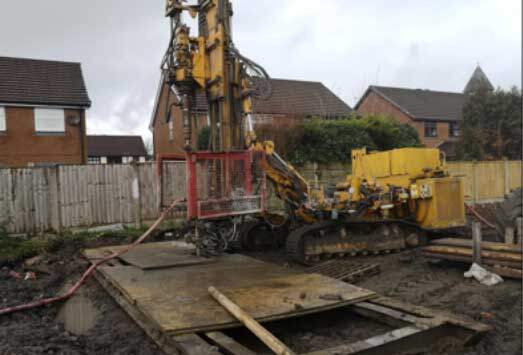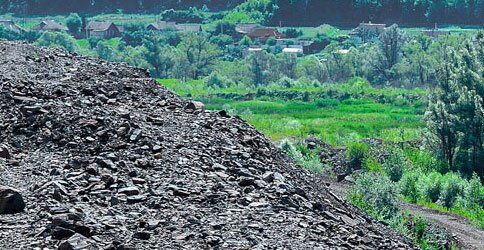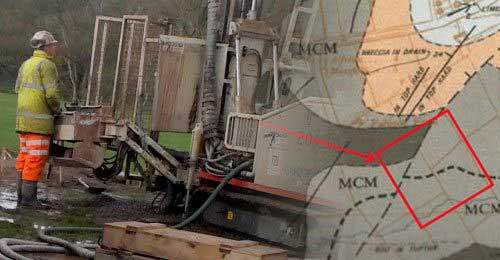Are your plans undermined? How a Coal Mining Risk Assessment can help
If you’re buying a property or land for development, particularly for a proposed planning application, you need to know whether it’s affected by coal mining activity. In July 2011, The Coal Authority formalised its requirements in relation to planning applications in England, Scotland and Wales for all except householder developments. Earth Environmental & Geotechnical has completed many Coal Mining Risk Reports for residential, commercial and industrial properties, and has extensive experience in relating these risk assessments to planning applications.
As part of a planning application we developed a Coal Mining Risk Assessment, which highlighted the presence of a suspected abandoned mine shaft on neighbouring land, but close to the development (residential) site boundary.
Coal mining was a widespread, major industry that drove the industrial revolution and two World Wars – consumption peaked in 1913 at 287 million tonnes, and virtually disappeared following the industry’s collapse after 1970. There are several ways of extracting coal. Open pit methods are used where coal strata strike the surface or are relatively shallow. Underground, or deep mining began to develop extensively in the late 18th century, and rapidly expanded throughout the 19th and early 20th centuries. The last deep coal mine in the UK closed in 2015. Coalfields helped many areas prosper, attracting industry and driving the growth of population and building. Britain’s coalfields are associated (but not exclusively) with Northumberland and Durham, North and South Wales, Yorkshire, the Scottish Central Belt, Lancashire, Cumbria, the East and West Midlands, and Kent
Surface physical evidence of where coal mines exist is rare. Without a Coal Mining Risk Assessment, there is often no way of knowing whether your site is affected by coal mining. The coalfield is divided into two areas, referred to as Development High Risk Area, and Development Low Risk Area. High Risk Area forms around 15% of the coalfield area, and is where coal mining risks are present at shallow depths likely to affect new development. The remaining 85% of the coalfield is the Low Risk Area, where past coal mining activity was sufficiently deep to pose a low risk.
A Coal Mining Risk Assessment needs to be prepared by a competent person, such as Earth Environmental & Geotechnical. Assessments we carry out aim to identify site specific coal mining risks. Then, where possible, we can propose a strategy to show how the site can be made stable for your proposed development. If your site is in a Development High Risk Area, we will help submit a Coal Mining Risk Assessment to your Local Planning Authority in support of your planning application.
A ‘competent person’ is considered to be someone qualified in a relevant subject, such as geology, geotechnical engineering, mineral surveying, mining engineering, or structural engineering. Our experts are highly competent in preparing desk-based assessments. We also benefit from the qualifications needed to satisfy the Coal Authority’s consideration that desk-based reports should be signed off by a chartered engineer or geologist with at least 3 years’ experience in ground investigation. The Coal Authority is a statutory consultee for any planning application within a High Risk Area.
The mapping of coal mines and workings across the country is well documented for historically recent activity. As well as archived records, interactive maps and data are available online that provide a good indication of risk areas, coal mines, mine entry points, surface coal resource areas, fissures and breaklines, probably shallow coal workings, coal outcrops, abandoned mines, and more. However, as with all data, it takes experienced people such as our own professionals to understand, interpret and extract the information held, and apply it confidently to a particular property or site.
A Coal Mining Risk Assessment will often be based on desk-based research, put together by reviewing existing data and documents, however if a site has mine entries then it’s highly likely we’ll need to carry out intrusive site investigations, which will be included in the report. The Coal Authority has a policy of avoiding building or development on, or close to, mine entries, even after they’ve been capped.
Every investigation is different, however an appropriate Coal Mining Risk Assessment should include a description and layout of the proposed development, including if possible the planning application description and plans. The sources of information used in the report should also be included; these could be a current consultants coal mining report, mine abandonment plans geological information, a site history based on historic mapping of the area, past desk-based assessments of ground conditions for the application site or nearby sites, results of past intrusive site investigations works carried out to assess ground conditions for this or nearby sites. When we identify and assess specific coal mining risks associated with the site, we take into account more specific risks, such as mine entries, shallow coal workings (recorded and probable), workable coal seam outcrops and former surface mining sites, mine gas, recorded coal mining related hazards, and geological features including fissures and break lines.
Coal Mining Risk Assessments for residential, commercial and industrial properties performed Earth Environmental & Geotechnical are often also informed by information sources including an assessment of the Coal Authority Mining Report, a visit to the Coal Authority offices to assess mining plans, a review of historical and modern published geological maps, and a review of technical reports and memoirs. Additionally, the British Geological Survey can be contacted for information on coal exploration, water-well and borehole information relevant to the site. The range of resources we consult also includes the Coal Authority Interactive Map Viewer; a Consultants Coal Mining Report from the Coal Authority; British Geological Survey 1/10,000 mapping showing coal outcrops, faulting and boreholes; Applied Geological reports and thematic mapping; and British Geological Survey Boreholes Records and Survey Memoirs.
Where coal mining features are found to be present, we can perform a more detailed assessment of the risks to the particular site and development, in which individual and cumulative risks can be considered.
With coal mines so widespread, and numerous in certain areas, it is inevitable that developments are constructed over abandoned mine workings. If development proposals are affected by the results of a Coal Mining Risk Assessment, we can help you set out a mitigation strategy; identifying issues, with mitigation measures included as necessary. If these include intrusive activities that will disturb coal seams or workings, or coal mine entries or shafts, then a Coal Authority permit is required – in which case our experts are here to help.
For more information on the Coal Mining Risk Assessment services provided by Earth Environment and Geotechnical, call us on 0161 975 6088, or visit our relevant website page: www.earthenvironmental.co.uk/coal-mining-risk-assessment/






